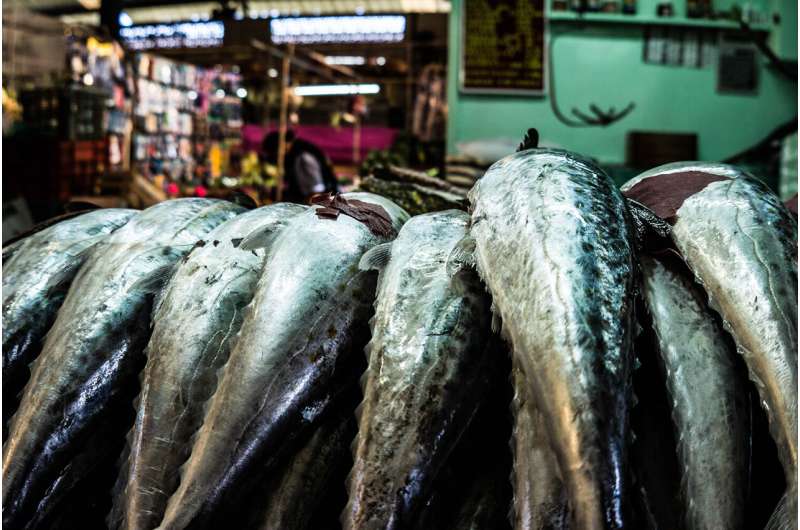More aquatic foods could be key to improving global health

Not all food is created equal. So-called blue foods—a diverse range of aquatic animals, plants and microorganisms—offer significantly more nutrients than land-based crops and livestock, according to a first-of-its-kind database compiled by an international team that included researchers at Stanford.
Their findings and recommendations, published Sept. 15 in Nature, point the way to feeding more people, improving diets and overcoming food system structures that put women, children and the elderly at greater risk.
"An increase in the supply of aquatic foods can pull millions from nutrient deficiencies around the world," said study co-lead author Zach Koehn, an early career fellow at Stanford's Center for Ocean Solutions. "To do so, we need to promote the diversity of aquatic foods arising from sustainable production, incentivize access to affordable foods and prioritize their supply to programs serving nutritionally vulnerable communities."
Due to malnutrition, nearly 2 billion adults are overweight or obese while 462 million are underweight. About half of all children have micronutrient deficiencies, which can lead to symptoms including fatigue, stunted growth, impaired brain development and even death. Cardiovascular diseases, largely driven by diet-related factors, kill more people than any other cause. This is in part due to a worldwide transition away from nutrient-rich, raw or lightly processed foods towards highly processed, calorie-rich, nutrient-poor foods common among Western diets.
Blue foods—a rich source of micronutrients and heart-healthy fatty acids—offer a potential solution.
Despite their promise, blue foods have been largely overlooked or undervalued by major international food system assessments, dialogs and funders, such as the World Bank. The researchers attribute this oversight to a narrow view of blue foods' diversity that ignores many species and forms of production, as well as a lack of data on blue foods' untapped potential to meet the nutritional needs of vulnerable populations around the world.
"The diversity of blue foods makes it ideal for providing critical nutritional benefits to the global population," said study lead author Christopher Golden, an ecologist and epidemiologist at the Harvard T.H. Chan School of Public Health. "As these foods are often a low impact on the environment, we can't afford to overlook this potential pathway to healthy and sustainable food systems."
Nutrition database and a blue foods future
To bridge the gap, the researchers compiled the most complete database of aquatic food nutrient composition to date, spanning 3,750 species and hundreds of nutrients, minerals, vitamins and fatty acids. The analysis compares blue foods to land-based livestock and animal products, such as chicken, beef, eggs and milk. Among other findings, it reveals that the top 6 categories of nutrient-rich animal-source foods are all aquatic foods, including shellfish, salmon and a variety of pelagic fish, such as sardines, tuna and mackerel.
"This research propels the growing narrative around the nourishing power of aquatic food systems, especially in low- and middle-income countries," said study co-author Shakuntala Thilsted of the non-profit research and innovation organization WorldFish, One CGIAR.
With the database as a foundation, the researchers modeled two plausible future scenarios by the year 2030: moderate growth in aquatic food production and high growth via sustainable intensification. The high growth scenario led to a 15 percent increase in supply, driven largely by investment and innovation in aquaculture production.
By comparing changes in aquatic foods consumption between the scenarios, the researchers were able to illuminate geographic and demographic vulnerabilities and estimate health impacts from diet-related diseases in 191 countries. They found the high production scenario led to a 26 percent decrease in the international reference price of aquatic foods, and a spike in blue foods consumption that reduced demand for red and processed meats. The overall health effect: a reduced risk of hypertension, stroke, heart disease, colorectal cancer and breast cancer and an end to micronutrient deficiencies for 166 million people.
Women, children and the elderly stand to benefit the most from increased access to blue foods. This is because of higher risk for adverse health outcomes among each of these demographics, and the critical role micronutrients and Omega-3s play in fetal and child growth and development. Perhaps unsurprisingly, the high output scenario benefited females more than males in three times as many countries. This finding provides a potential pathway towards nutritional equity and improving fetal and child growth and development. Similarly, blue foods' impact on lowering morbidity and mortality would be more beneficial for older people who are at most risk of those outcomes.
To ensure blue foods benefits reach those who need them most, the researchers call for directing aquatic food production and consumption to target a range of nutrient deficiencies. For instance, a country in which many people suffer from calcium deficiency might promote increased production and consumption of calcium-rich fish, such as herrings and sardines. The researchers also highlight promising innovations, such as fish powder baby food and fish chutney for pregnant and lactating women, that could help deliver nutrients to those in need more easily and affordably.
"Blue foods can and should be a key part of a healthier, more equitable global food system," Koehn said. "Our research lays the groundwork for policies and interventions to get there."
Policy Recommendations
- Strengthen supply chains and availability of aquatic foods in countries where there are high burdens of micronutrient deficiencies by improving fisheries management; enhancing sustainable aquaculture; and building more equitable national and regional trade networks;
- Promote a diversity of nutrient-rich aquatic foods in sustainable aquaculture systems through national dietary guidelines, and target public health interventions toward particular nutritional deficiencies among vulnerable populations living in particular geographies;
- Incentivize access and affordability of aquatic foods in countries experiencing a rapid transition to less healthy foods;
- Prioritize aquatic foods in social protection programs including food assistance, school meal programs and safety nets for the most nutritionally vulnerable, including pregnant and lactating women, young children and the elderly.
More information: Jessica A. Gephart et al, Environmental performance of blue foods, Nature (2021). DOI: 10.1038/s41586-021-03889-2
Journal information: Nature
Provided by Stanford University




















